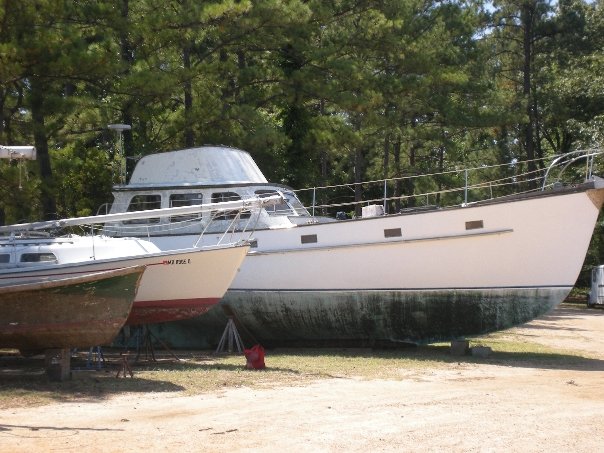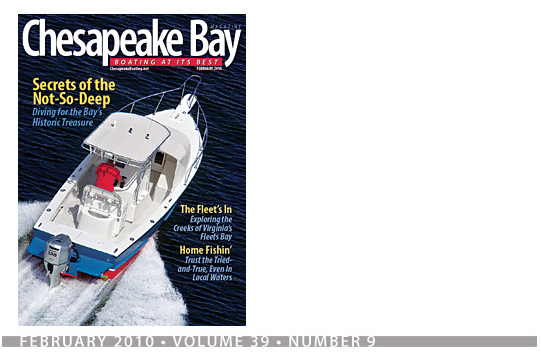oldseacock
worstleak
rottensole
snowonthebow
snowcovereddeck
Check out the solid ice in the hold up to the top of the rudder-post. Somewhere down there’s a bilge pump.
Blizzard
About a foot of snow fell on Tall Timbers this weekend.
Gypsy

The Boat: “Gypsy”, a 41′ fiberglass motorsailer, built sometime in the 1970s. Currently “on the hard” at Tall Timbers Marina in Maryland, and has been for the better part of 20 years. This picture was taken in August, 2009.
The Plan: Refurbish and refit her, with the goal of a comfortable liveaboard, and potentially cruise to the Caribbean– some place warm with clear water.
Gypsy was abandoned on shore– the previous owner paid her dockage fees like clockwork, apparently with the intention of someday refurbishing her himself. He unfortunately died before realizing this dream. His surviving family apparently did not share this sentiment– they paid one month’s slip fee, came to visit and took one look… and ran. Never paid anything again.
Learning of this last summer, we struck a deal with the marina owner: he would acquire the title through the abandonment laws, we would pay the back-dockage, and he would sign the title over to us. From then on, we’d pay the ongoing dockage, of course. A win-win, right? Well, we’ll see about that.
When we first went aboard for a look, we found a true diamond-in-the-rough. Trash scattered everywhere, rotted panels falling away from the bulkheads from water incursion– the aft hold hatch-covers were stove in, the aft hold filled with mud and pine-needles. There was the mummified remains of a cat draped over a cleat on the fore-deck; one area of the aft hold had a healthy layer of green moss. A fellow IMHer quipped “you’ll need a wetlands permit to clean that up!”
But underneath the years’ accumulation of detritus was a solid hull without a single soft-spot– this fiberglass hull is five inches thick at the turn of the bilge. Rapping your knuckles on the hull feels more like knocking on cinder-block than on a wooden door, like other fiberglass hulls. The deck is similarly built, with a teak top layer. The teak itself is dirty and has some strips popping up, but there’s no sign of water incursion through the deck– only a couple of leaks where the deck meets the hull, around the salon windows and through the air vents from the bridge. Most of the wood rot and mildew, it turns out, is due to condensation over the years.
So far, I’ve inspected and repaired, replaced or capped most of the thru-hulls and sea-cocks. Both stuffing boxes have been cleaned out and are waiting for new packing, once the port shaft is repaired/replaced. It has some pit-corrosion at the stuffing-box that needs attention. She has three working bilge-pumps and a battery now, so no more wetlands in the aft hold. I still need to rehab the rudder packing gland and finish the thru-hulls and sea-cocks. The noxious fluid-that-was-once-diesel in the fuel tanks needs to be pumped out and disposed of and the tanks cleaned. The bottom needs to be sanded and painted– might as well do that before we put her back in the water. With persistence, I hope to have her floating by late spring.
We decided to rename her, but haven’t come up with a new name yet. The proper denaming ceremony will be performed to appease Mighty Neptune before she is re-christened– complete with a re-launching party!
Now I’m off to install bilge-pump switches…
–Kirk
Gypsy, Aug. 2009
Chesapeake Bay magazine, February 2010 issue
The February issue just came out and has a cover article about IMH and the U-1105.
Secrets of the Not-So-Deep
“Splash! Jody Argo Schroath dons her cold weather gear to spend a few days with members of the Institute of Maritime History (IMH). These hardy scuba divers spend their free time diving the murky waters of the Bay – searching for, preserving and keeping a lid on the whereabouts of the Chesapeake’s shipwrecks.”
